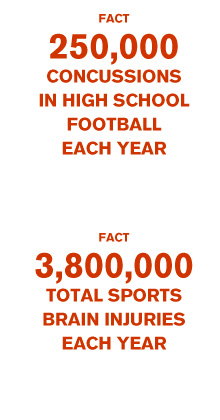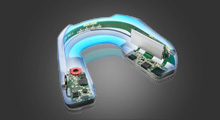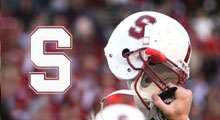Determining playing status. From inside the player’s head.
In recent years, the widespread occurrence of mild traumatic brain injury (mTBI), also known as concussion, has been brought to the forefront of the public’s attention. mTBI is frequently sustained by athletes engaging in contact sports and military personnel on active duty (references 1-4). One of the problems faced by the scientists investigating the pathology of mTBI is a lack of data regarding the association between injury and different types of impact forces. Concussions, while numerous on a national scale, are hard to capture in a systematic way that allows for the measurement of the impact parameters (references 5, 6).
Measuring head impacts.
Existing methods of measuring head impacts received by players engaging in contact sports in vivo utilize sensors attached to a player’s helmet. We investigated an alternative method of capturing accelerations experienced by the brain during head impacts by positioning linear accelerometers and gyroscopes at the upper jaw and generating a map of accelerations using virtual projection sensors (VPS). We have previously shown that peak linear accelerations (PLA) captured with an instrumented mouthguard had a nearly perfect correlation (R2 = .995) with the PLA recorded at the headform center of gravity (CG). In order to validate the use of the mouthguard as an impact sensor, we compared PLA and rotational velocities (RV) measured with the sensors positioned at the mouthguard (MG) with those measured at the CG of a simulated human skull (SHSL) impacted with a weighted pendulum. We validated the VPS system by comparing the PLA measured at the SHSL CG with those calculated using VPS. We found that the peak linear accelerations and rotational velocities measured at the MG were closely correlated with those measured at the SHSL CG (R2 > .995). Additionally, calculation of linear accelerations via VPS predicted the PLA at CG within 2 Gs.
An instrumented mouthguard provides a convenient method of measuring head impacts sustained by athletes and soldiers in a variety of settings.
References:
1. Langlois JA, Rutland-Brown W, Wald MM. The epidemiology and impact of traumatic brain injury: a brief overview. J Head Trauma Rehabil. Sep-Oct 2006;21(5):375-378.
2. Guskiewicz KM, Weaver NL, Padua DA, Garrett WE, Jr. Epidemiology of concussion in collegiate and high school football players. Am J Sports Med. Sep-Oct 2000;28(5):643-650.
3. Thurman DJ, Branche CM, Sniezek JE. The epidemiology of sports-related traumatic brain injuries in the United States: recent developments. J Head Trauma Rehabil. Apr 1998;13(2):1-8.
4. Snell FI, Halter MJ. A signature wound of war: mild traumatic brain injury. J Psychosoc Nurs Ment Health Serv. Feb 2010;48(2):22-28.
5. Broglio SP, Schnebel B, Sosnoff JJ, et al. The Biomechanical Properties of Concussions in High School Football. Med Sci Sports Exerc. Mar 25.
6. McCaffrey MA, Mihalik JP, Crowell DH, Shields EW, Guskiewicz KM. Measurement of head impacts in collegiate football players: clinical measures of concussion after high- and low-magnitude impacts. Neurosurgery. Dec 2007;61(6):1236-1243; discussion 1243.

Concussion resources
Get smart about concussions. Learn how to better understand and identify concussions:
www.cdc.gov
www.brainandspinalcord.org
Lystedt Law
Available soon.
The Impact Intelligence System is currently available on a limited, pre-production basis. Market launch is planned for 2012.

Keep in touch.
Find us on Facebook for the latest updates and news about all of our products.

High-tech electronics.
The Impact Sensing Mouthguard accurately measures impacts and accelerations.

Stanford University.
The Stanford University football team is testing the Impact Intelligence System.

Make an impact.
Join the fight - sponsor a team and help keep concussions out of the game.